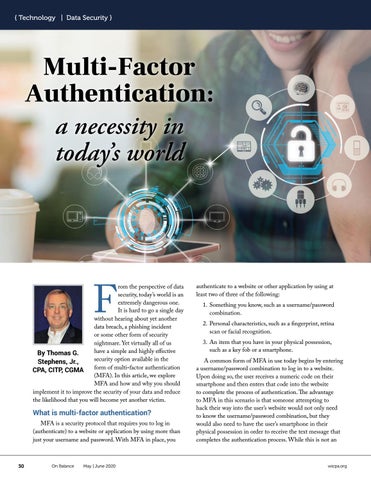{ Technology | Data Security }
Multi-Factor Authentication: a necessity in today’s world
F
rom the perspective of data security, today’s world is an extremely dangerous one. It is hard to go a single day without hearing about yet another data breach, a phishing incident or some other form of security nightmare. Yet virtually all of us have a simple and highly effective By Thomas G. security option available in the Stephens, Jr., form of multi-factor authentication CPA, CITP, CGMA (MFA). In this article, we explore MFA and how and why you should implement it to improve the security of your data and reduce the likelihood that you will become yet another victim.
What is multi-factor authentication? MFA is a security protocol that requires you to log in (authenticate) to a website or application by using more than just your username and password. With MFA in place, you
30
On Balance
May | June 2020
authenticate to a website or other application by using at least two of three of the following: 1. Something you know, such as a username/password combination. 2. Personal characteristics, such as a fingerprint, retina scan or facial recognition. 3. An item that you have in your physical possession, such as a key fob or a smartphone. A common form of MFA in use today begins by entering a username/password combination to log in to a website. Upon doing so, the user receives a numeric code on their smartphone and then enters that code into the website to complete the process of authentication. The advantage to MFA in this scenario is that someone attempting to hack their way into the user’s website would not only need to know the username/password combination, but they would also need to have the user’s smartphone in their physical possession in order to receive the text message that completes the authentication process. While this is not an
wicpa.org





